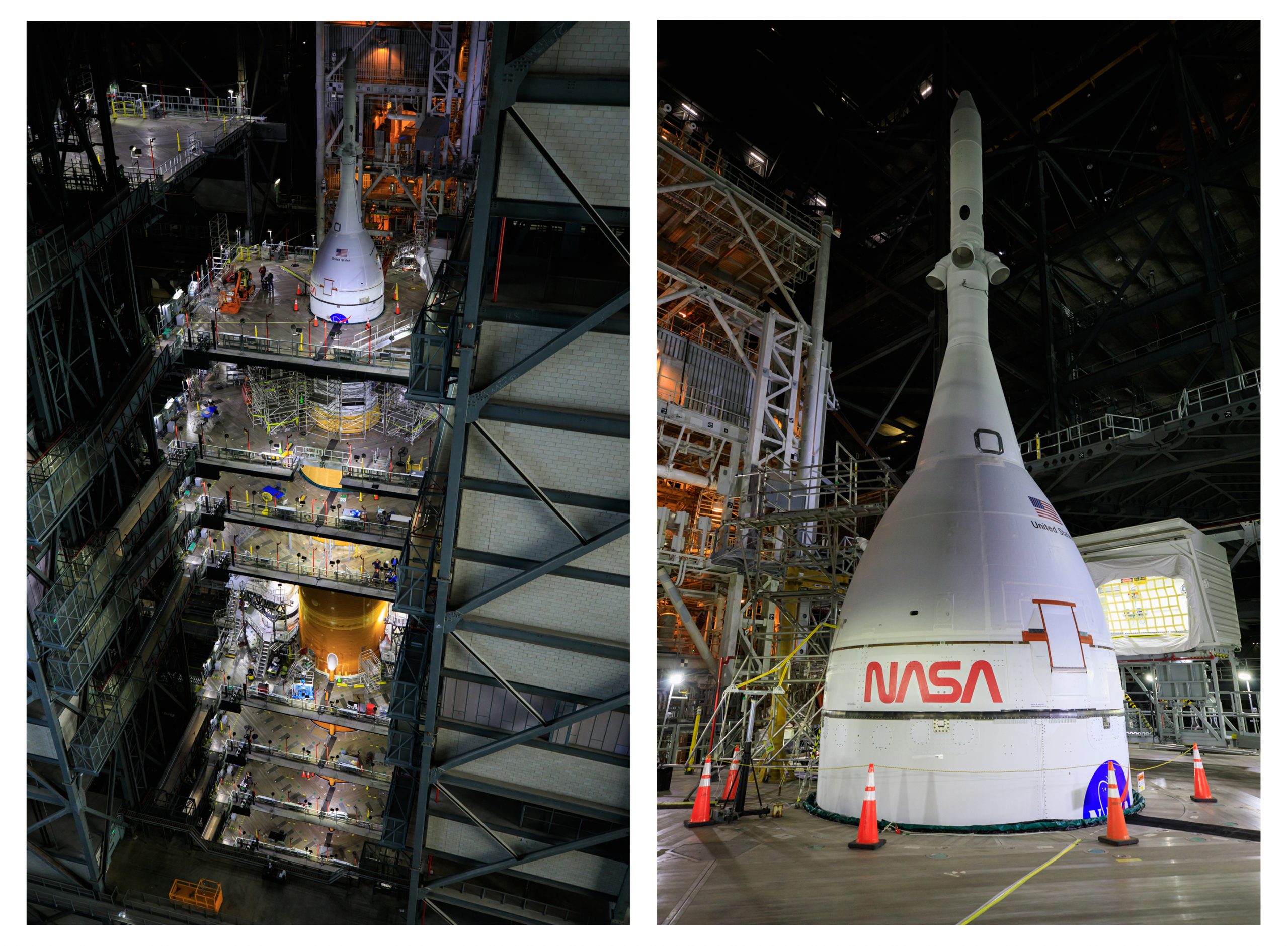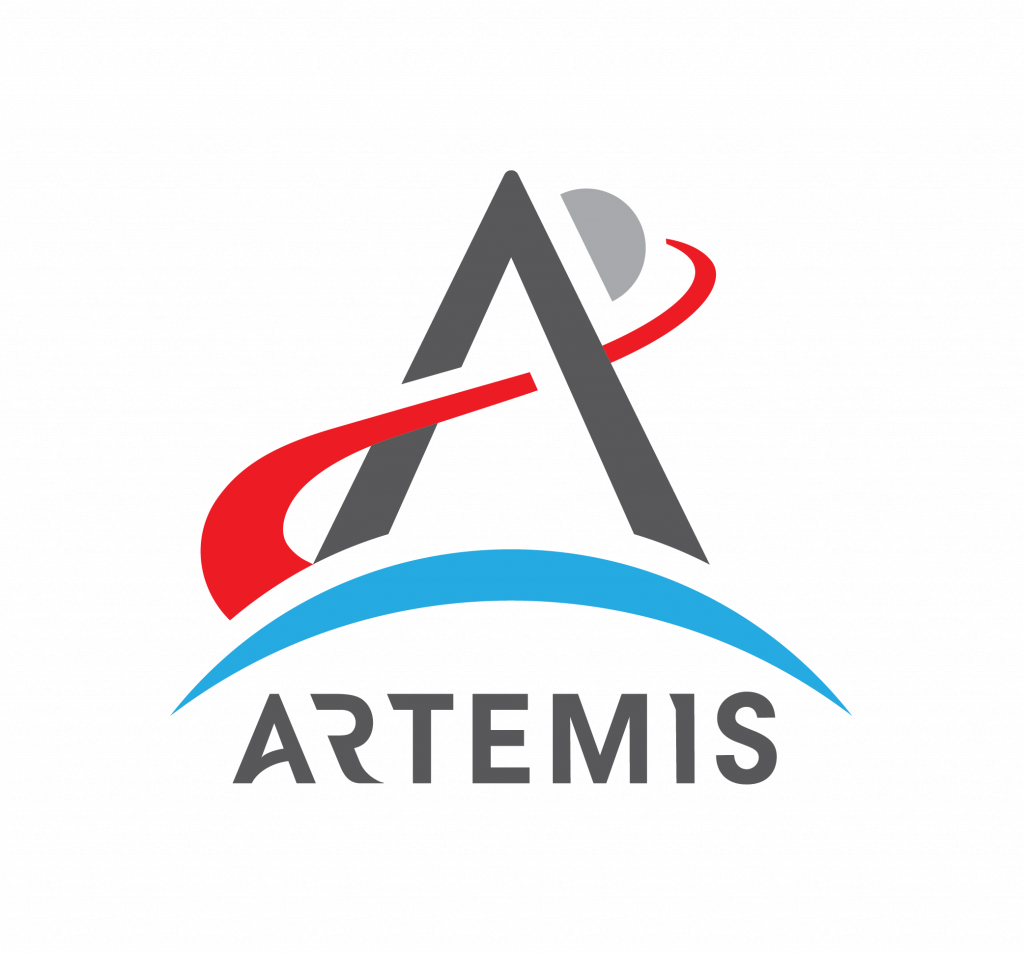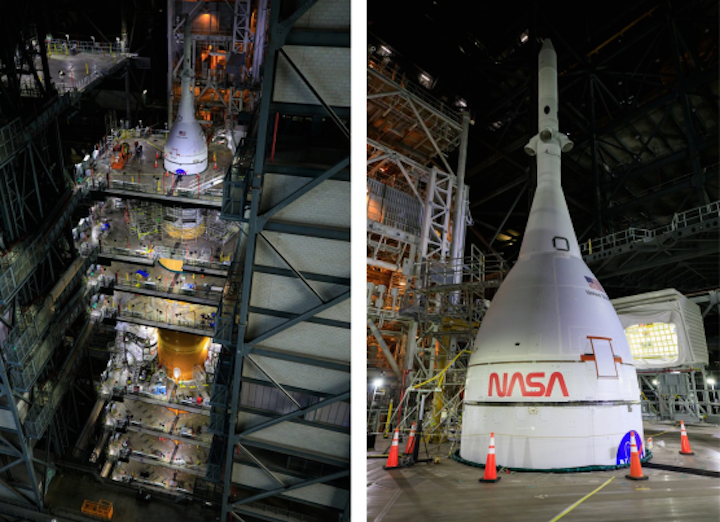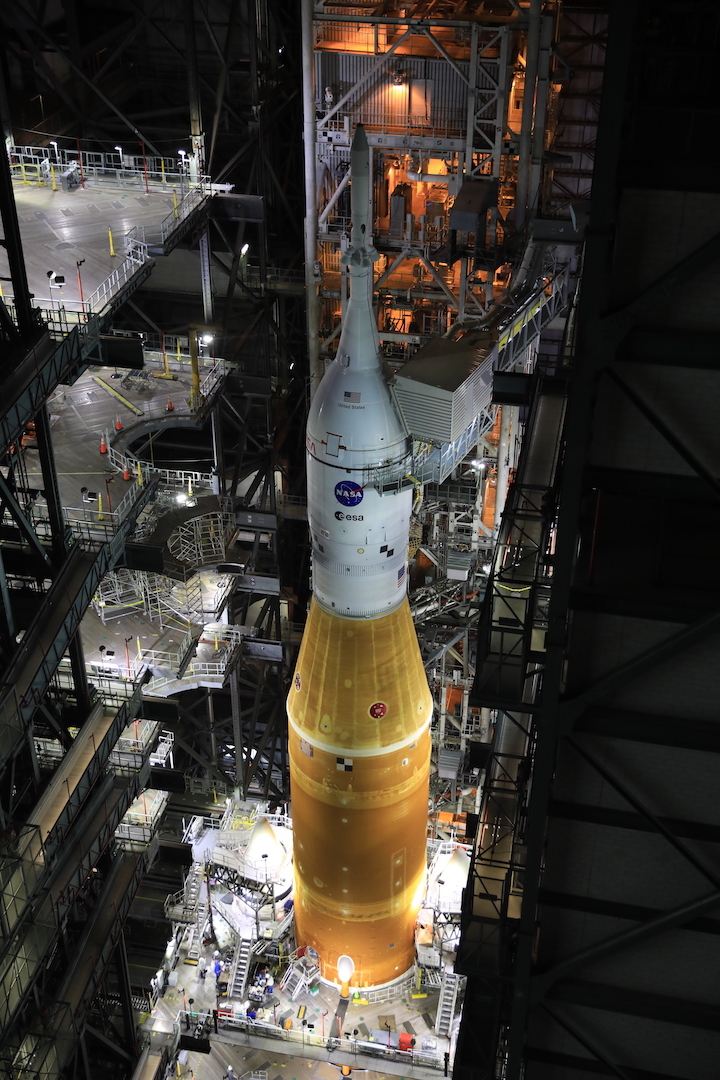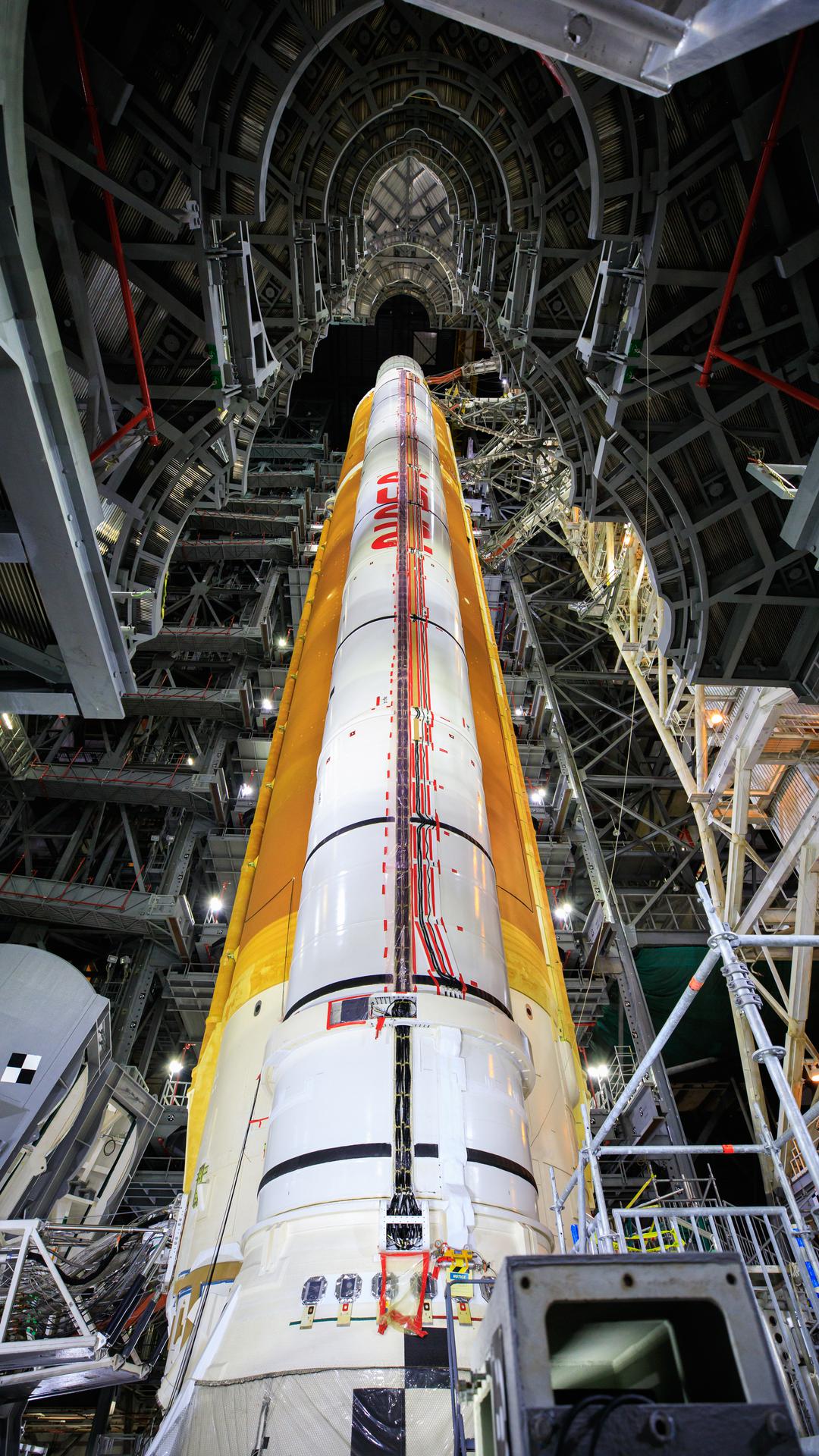NASA’s Space Launch System (SLS) rocket with the Orion spacecraft aboard is seen illuminated by spotlights atop a mobile launcher at Launch Complex 39B, Friday, March 18, 2022, after being rolled out to the launch pad for the first time at NASA’s Kennedy Space Center in Florida. Ahead of NASA’s Artemis I flight test, the fully stacked and integrated SLS rocket and Orion spacecraft will undergo a wet dress rehearsal at Launch Complex 39B to verify systems and practice countdown procedures for the first launch.
Credits: NASA
NASA’s Space Launch System (SLS) rocket with the Orion spacecraft atop arrived at Launch Pad 39B at the agency’s Kennedy Space Center in Florida Friday in preparation for a final test before its Artemis I Moon mission.
The Moon is seen rising behind NASA’s Space Launch System (SLS) rocket with the Orion spacecraft aboard atop a mobile launcher as it rolls out to Launch Complex 39B for the first time, Thursday, March 17, 2022, at NASA’s Kennedy Space Center in Florida. Ahead of NASA’s Artemis I flight test, the fully stacked and integrated SLS rocket and Orion spacecraft will undergo a wet dress rehearsal at Launch Complex 39B to verify systems and practice countdown procedures for the first launch.
Credits: NASA
The uncrewed flight test will pave the way for missions to land the first woman and first person of color on the Moon under Artemis, and the rocket rolled to the pad for a final test before launch.
“From this sacred and historical place, humanity will soon embark on a new era of exploration,” said NASA administrator Bill Nelson. “Artemis I will demonstrate NASA’s commitment and capacity to extend humanity’s presence on the Moon – and beyond.”
Stacked on the mobile launcher and mounted on the crawler-transporter for a journey from the Vehicle Assembly Building to Launch Pad 39B, it took 10-hours and 28 minutes for SLS and Orion to reach the launch pad four miles away. The trip began at 5:47 p.m. Thursday, March 17, and the 322-foot tall, 3.5-million-pound rocket and spacecraft arrived at the pad at 4:15 a.m. on March 18.
The upcoming final test, known as the wet dress rehearsal, will run the Artemis I launch team through operations to load propellant into the rocket’s tanks, conduct a full launch countdown, demonstrate the ability to recycle the countdown clock, and also drain the tanks to practice the timelines and procedures the team will use for launch.
“Rolling out of the Vehicle Assembly Building is an iconic moment for this rocket and spacecraft, and this is a key milestone for NASA,” said Tom Whitmeyer, deputy associate administrator for Common Exploration Systems Development at NASA Headquarters in Washington. “Now at the pad for the first time, we will use the integrated systems to practice the launch countdown and load the rocket with the propellants it needs to send Orion on a lunar journey in preparation for launch.”
Before the test, SLS, Orion, and the associated ground systems will undergo checkouts at the pad. After the rehearsal, NASA will review data from the test before setting a specific target launch date for the upcoming Artemis I launch. The integrated rocket and spacecraft will roll back to the Vehicle Assembly Building several days after the test to remove sensors used during the rehearsal, charge system batteries, stow late-load cargo, and run final checkouts. Orion and SLS will then roll to the launch pad for a final time about a week before launch.
With Artemis, NASA will establish long-term exploration at the Moon in preparation for human missions to Mars. SLS and NASA’s Orion spacecraft, along with the human landing system and the Gateway in orbit around the Moon, are NASA’s foundation for deep space exploration.
Quelle: NASA
----
Update: 25.03.2022
.
NASA Provides Update to Astronaut Moon Lander Plans Under Artemis
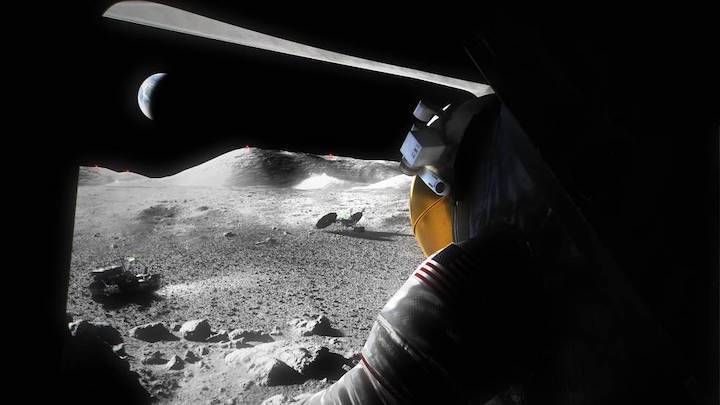
An illustration of a suited Artemis astronaut looking out of a Moon lander hatch across the lunar surface, the Lunar Terrain Vehicle and other surface elements.
Credits: NASA
As NASA makes strides to return humans to the lunar surface under Artemis, the agency announced plans Wednesday to create additional opportunities for commercial companies to develop an astronaut Moon lander.
Under this new approach, NASA is asking American companies to propose lander concepts capable of ferrying astronauts between lunar orbit and the lunar surface for missions beyond Artemis III, which will land the first astronauts on the Moon in more than 50 years.
Built and operated according to NASA’s long-term requirements at the Moon, new landers will have the capability to dock to a lunar orbiting space station known as Gateway, increase crew capacity, and transport more science and technology to the surface.
“Under Artemis, NASA will carry out a series of groundbreaking missions on and around the Moon to prepare for the next giant leap for humanity: a crewed mission to Mars,” said NASA Administrator Bill Nelson. “Competition is critical to our success on the lunar surface and beyond, ensuring we have the capability to carry out a cadence of missions over the next decade. Thank you to the Biden Administration and Congress for their support of this new astronaut lander opportunity, which will ultimately strengthen and increase flexibility for Artemis.”
NASA’s plans call for long-term lunar exploration and include landing the first woman and first person of color on the Moon as part of future Artemis missions. The agency is pursuing two parallel paths for continuing lunar lander development and demonstration, one that calls for additional work under an existing contract with SpaceX, and another open to all other U.S. companies to provide a new landing demonstration mission from lunar orbit to the surface of the Moon.
In April 2021, NASA selected SpaceX as its partner to land the next American astronauts on the lunar surface. That demonstration mission is targeted for no earlier than April 2025. Exercising an option under the original award, NASA now is asking SpaceX to transform the company’s proposed human landing system into a spacecraft that meets the agency’s requirements for recurring services for a second demonstration mission. Pursuing more development work under the original contract maximizes NASA’s investment and partnership with SpaceX.
To bring a second entrant to market for the development of a lunar lander in parallel with SpaceX, NASA will issue a draft solicitation in the coming weeks. This upcoming activity will lay out requirements for a future development and demonstration lunar landing capability to take astronauts between orbit and the surface of the Moon. This effort is meant to maximize NASA’s support for competition and provides redundancy in services to help ensure NASA’s ability to transport astronauts to the lunar surface.
This upcoming second contract award, known as the Sustaining Lunar Development contract, combined with the second option under SpaceX’s original landing award, will pave the way to future recurring lunar transportation services for astronauts at the Moon.
“This strategy expedites progress toward a long-term, sustaining lander capability as early as the 2026 or 2027 timeframe,” said Lisa Watson-Morgan, program manager for the Human Landing System Program at NASA’s Marshall Space Flight Center in Huntsville, Alabama. “We expect to have two companies safely carry astronauts in their landers to the surface of the Moon under NASA’s guidance before we ask for services, which could result in multiple experienced providers in the market.”
After the new draft solicitation is published, NASA will host a virtual industry day. Once comments and questions from the draft solicitation process have been reviewed, the agency plans by to issue the formal request for proposals this summer.
Astronaut Moon landers are a vital part of NASA’s deep space exploration plans, along with the Space Launch System rocket, Orion spacecraft, ground systems, and Gateway. NASA is committed to using a commercial astronaut lunar lander to carry the astronauts to the surface of the Moon, expanding exploration and preparing humanity for the next giant leap, human exploration of Mars.
Quelle: NASA
----
Update: 27.03.2022
.
Moon rocket test gets priority, for now, over commercial astronaut
launch
NASA is pressing ahead with plans to start a three-day dress rehearsal countdown for the agency's new SLS/Artemis-1 moon rocket on April 1, officials said Friday. The plan gives the test priority over the planned April 3 launch of a SpaceX Crew Dragon capsule for the first privately-funded civilian flight to the space station.
If SLS processing stays on schedule, the rocket will be loaded with propellant and the countdown will tick down to within 10 seconds of a make-believe launch on April 3. The actual launch of a Falcon 9 rocket from nearby pad 39A would then slip one or two days to give engineers time to replenish stores of nitrogen gas used at both launch pads.
But if the SLS team runs into problems leading up to the "wet dress rehearsal" and is delayed, the SpaceX flight, chartered by Houston-based Axiom Space, will take off on April 3 as had been planned, carrying a retired NASA astronaut and three wealthy entrepreneurs to the space station for an eight-day stay.
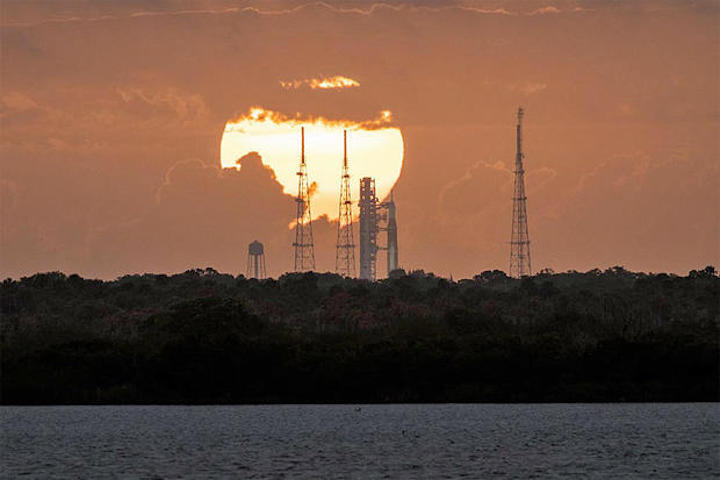
The sun rises behind the Space Launch System Artemis-1 rocket atop pad 39B at the Kennedy Space Center Thursday. NASA plans to carry out a dress rehearsal countdown and fueling test April 1-3 to clear the way for launch in the late May-early June timeframe.NASA
"Artemis 1 wet dress has the range," NASA space operations chief Kathy Lueders said after a formal flight readiness review. She was referring to U.S. Space Force tracking and telemetry support required for all East Coast launches. "Our plan is to get (the countdown test) done as early as possible."
NASA plans to launch the towering SLS rocket on its maiden flight, an unpiloted trip beyond the moon and back, in the early June timeframe. The team wants to get the countdown test done as soon as possible so they can move the rocket back into the protection of its processing hangar — and out of any threatening weather — for final pre-flight processing and to resolve any issues that might come up in the test.
But the Axiom-1, or AX-1, mission presents its own challenges. If the rocket is not off the pad by April 7, NASA's next Crew Dragon astronaut flight to the station, now targeted for launch on April 19, could be delayed, triggering a domino-like slip for the April 26 return to Earth of the four astronauts that crew is replacing.
Delays are an issue in part because of temperature constraints based on the space station's orbit with respect to the sun. Lueders said mission managers are in daily contact and the schedule should come into sharper focus over the next week or so.
"We've still got eight to 10 days of processing on both sides for us to (reach a decision)," she said. "So (SLS is) getting ready for their wet dress, but we and Axiom and the SpaceX team are also getting ready to be able to launch as closely to April 3 as possible."
To get a sense of the schedule complexities facing NASA and SpaceX, consider April 1. SpaceX plans to carry out a "dry" countdown rehearsal for the AX-1 team that morning, followed by launch of another Falcon 9 from pad 40 at the nearby Cape Canaveral Space Force Station, followed by a test firing of the AX-1 Falcon 9 on pad 39A. All that will be followed by the start of the SLS practice countdown.
Lueders said the busy launch schedule "is a good problem to have."
"From a planning perspective, it made a lot of sense to us to just get the wet dress mission done," she said. "It lets the Artemis team be able to go through that data and the reconfiguration (for flight) and then begin getting ready for what's going to be a really historic launch in June."
Quelle: CBS News
----
Update: 30.03.2022
.
NASA to Provide Updates, Coverage for Final Test Ahead of Moon Mission
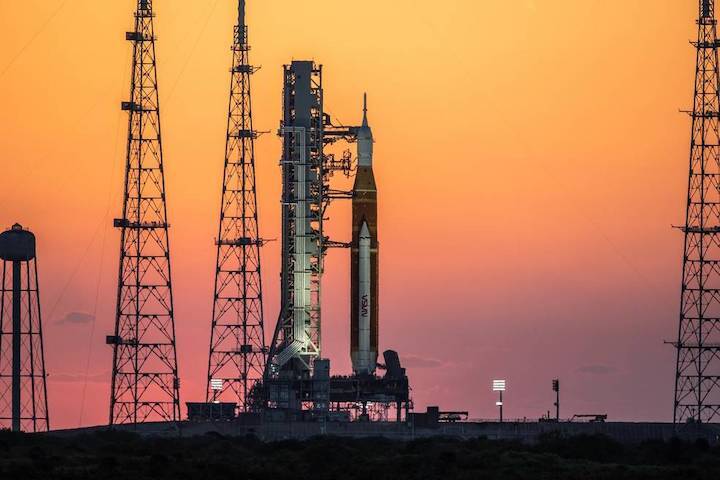
The sunrise casts a warm glow around the Artemis I Space Launch System (SLS) and Orion spacecraft at Launch Pad 39B at NASA’s Kennedy Space Center in Florida on March 21, 2022. The SLS and Orion atop the mobile launcher were transported to the pad on crawler-transporter 2 for a prelaunch test called a wet dress rehearsal. Artemis I will be the first integrated test of the SLS and Orion spacecraft. In later missions, NASA will land the first woman and the first person of color on the surface of the Moon, paving the way for a long-term lunar presence and serving as a steppingstone on the way to Mars.
Credits: NASA/Ben Smegelsky
NASA will hold a media teleconference at 1 p.m. EDT Tuesday, March 29, to discuss the upcoming final major test with the agency’s Mega Moon rocket and spacecraft at the launch pad ahead of the uncrewed Artemis I lunar mission.
The test, known as the wet dress rehearsal, is planned for Friday, April 1, through Sunday, April 3, on Launch Pad 39B at NASA’s Kennedy Space Center in Florida. During the test, engineers will demonstrate the ability to conduct a full launch countdown at the pad, including loading and draining cryogenic, or supercold, propellants into the Artemis I rocket.
Teleconference participants include:
- Tom Whitmeyer, deputy associate administrator for common exploration systems development, NASA Headquarters in Washington
- Charlie Blackwell-Thompson, Artemis launch director, NASA Exploration Ground Systems program, NASA Kennedy
- John Honeycutt, manager, Space Launch System program, NASA’s Marshall Space Flight Center in Huntsville, Alabama
- Howard Hu, manager, Orion program, NASA’s Johnson Space Center in Houston
- Mike Sarafin, Artemis mission manager, NASA Headquarters
To participate by telephone, media must RSVP no later than two hours prior to the start of the event to: ksc-newsroom@mail.nasa.gov.
The agency will provide live video of the rocket on the pad, without audio or commentary, beginning at 12 p.m. Friday, April 1, on the Kennedy Newsroom YouTube channel through the duration of the test. Real-time operations updates will be posted on the Artemis blog and social accounts. There are no in-person media activities planned for wet dress rehearsal.
The agency will also host a post-test media teleconference with the participants listed above at 11 a.m. April 4.
Through Artemis missions, NASA will land the first woman and the first person of color on the Moon, paving the way for a long-term lunar presence and serving as a steppingstone on the way to Mars.
Quelle: NASA
+++
Artemis I testing

Just a few miles north of Launch Complex 40, meanwhile, NASA's massive Space Launch System moon rocket still stands at pad 39B, waiting for a series of tests ahead of launch this summer.
NASA teams are targeting between Friday, April 1, and Sunday, April 3, for what's known as a "wet dress rehearsal," or series of tests that almost run through a mock launch countdown. It will include fueling the rocket at pad 39B.
If all goes well with the rehearsal, teams will conduct checkouts and roll the rocket back to the Vehicle Assembly Building, then prepare for its Artemis I mission no earlier than June. That will take an uncrewed Orion capsule on a trip around the moon, paving the way for an identical mission with astronauts on Artemis II no earlier than 2024.
NASA hopes to put two astronauts back on the lunar surface for Artemis III by 2025.
Quelle: Florida Today
----
Update: 2.94.2022
.
SLS Fueling Is Last Major Test Ahead Of Artemis I Launch
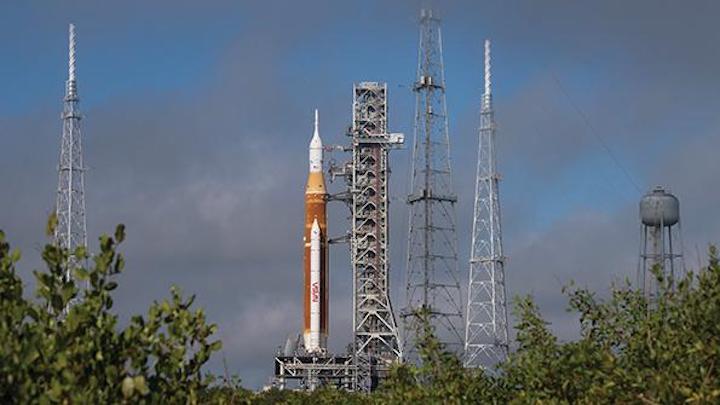
NASA’s decade-long, multibillion-dollar effort to restore crewed, deep-space transportation capabilities to the U.S. reached a final milestone ahead of launch: a two-day dress rehearsal that includes fueling the Space Launch System core and upper stages with 730,000 lb. of cryogenic propellants.
The Space Launch System (SLS) rocket, topped with an Orion capsule, rolled out from the Kennedy Space Center’s historic Vehicle Assembly Building (VAB) just before sunset on March 17, accompanied by a University of Central Florida marching band, 7,000 guests and a live NASA TV broadcast.
The vehicle’s arrival at Launch Complex 39B 10.5 hr. later set the stage for a wet dress rehearsal (WDR), which was scheduled for no earlier than April 1-3. The WDR is the last major test ahead of the SLS debut launch on the Artemis I mission, which will send the uncrewed Orion capsule on a flight test around the Moon. Liftoff is targeted for no earlier than June 6.
“This is our last design verification prior to our launch,” Tom Whitmeyer, associate administrator for common exploration systems development at NASA headquarters, told reporters on March 29. “We have done everything to get ready,” he added. “We will find out soon enough.”
The WDR primarily is intended to give the launch team practice fueling the vehicle and then draining it in the same environment as launch day. Ahead of the test, technicians checked interfaces between the mobile launcher and the pad and ran a series of tests that could not be accomplished in the VAB. Those included: communications tests, Orion radio frequency checks and guidance and navigation system checks on Orion and the SLS Interim Cryogenic Propulsion Stage (ICPS) upper stage. In addition, the hydraulic systems of the SLS’ solid rocket boosters were serviced.
The WDR was expected to get underway at 5 p.m. on April 1 with a “call to stations” for the test team. If all has gone well, on April 3 the SLS core and upper stages will be loaded with cryogenic liquid oxygen and hydrogen propellants, marking the first time the stages are fueled together.
The core stage tanks hold 537,000 gal. of liquid hydrogen and 196,000 gal. of liquid oxygen. The stage, built by Boeing, is designed to operate for about 480 sec. and then separate from the ICPS, the Orion stage adapter and the Orion capsule.
The core stage, which serves as the backbone of the SLS rocket, is powered by four RS-25 engines manufactured by Aerojet Rocketdyne. The engines, which will not be fired up during the WDR, were transferred from the space shuttle program, along with the shuttle solid rocket boosters, the mobile launcher platform and the launchpad.
NASA spent $20 billion on the SLS program in 2012-21, which covered development, testing and manufacturing of three core boosters and early work on an upgraded upper stage.
The ICPS, which will be used on the first three SLS flights, is a 45-ft.-tall, 16.7-ft.-dia. modified Delta Cryogenic Second Stage, which is used on United Launch Alliance’s (ULA) Delta IV launch vehicles. Manufactured by Boeing and ULA in Decatur, Alabama, the ICPS is designed to perform a translunar injection burn to send Orion toward the Moon. The stage, which is powered by a single Aerojet Rocketdyne RL10 engine, also contains the avionics to fly the mission from core stage separation to when Orion separates from the ICPS.
Modifications to the Delta stage for early SLS missions—a configuration referred to as Block 1—included lengthening the liquid hydrogen tank by 18.4 in. Other additions include: a second hydrazine bottle for attitude control, a new navigation system, Orion and launch vehicle stage adapter electrical and mechanical interfaces, a modified liquid-hydrogen vent and relief valve, and an RL10 inflight helium injector purge to support engine restart. The RL010 also had to be requalified to operate in SLS environments.
For the Artemis missions, the RL10 will conduct three burns. The first will circularize Orion’s orbit, the second will push the spacecraft out of Earth orbit toward the Moon and a final disposal burn after Orion separates will put the ICPS into a graveyard orbit around the Sun.
Joining the WDR team in Florida will be personnel at NASA’s Marshall Space Flight Center in Huntsville, Alabama, which oversees SLS development, and at NASA’s Johnson Space Center (JSC) in Houston, which is in charge of the Orion program. The capsule earmarked for the Artemis I flight test will be powered up and monitored throughout the WDR.
“This is a good practice run,” says Orion Program Manager Howard Hu. “We will have our engineering team from JSC and Mission Control do checkouts of the primary power, propulsion and communications systems. The flight software will be running, and the hatch closed.”
NASA has spent about $12 billion on the Orion program, including a 2014 flight test that launched aboard a ULA Delta IV Heavy booster.
Much of NASA’s confidence that the WDR will proceed smoothly is due to the amount of time and effort that has gone into preparations, says Charlie Blackwell-Thompson, the Artemis launch director at the Kennedy Space Center.
“We have tested all of the individual pieces. We have also run the software through a number of different simulations,” Blackwell-Thompson told reporters. “But it’s a test, so I’m certain as we go through things, we will learn.”
The WDR was expected to conclude by 5 p.m on April 3 after the launch team ran through countdown activities. The team planned to halt the rehearsal with 33 sec. left on the clock, cycle back to a 10-min. hold and then continue down to 10 sec. of what would be an actual liftoff. At that point, the team planned to proceed as if the launch had been scrubbed.
Ground teams expected then to drain the rocket and prepare to roll it back into the VAB for additional closeouts and tests while the outcome of the WDR was assessed. NASA leadership could be prepared to provide a time frame for launch the week of April 11.
The SLS and Orion will return to 39B about a week before the Artemis 1 is targeted to launch. If that occurs in the weeks following the WDR, a follow-on flight test, Artemis II, could send astronauts around the Moon and back to Earth in 2024. Artemis III, the first post-Apollo mission to land astronauts on the Moon, could follow in 2025.
Quelle: AVIATION WEEK
----
Update: 5.04.2022
.
NASA scrubs first attempt at SLS countdown rehearsal
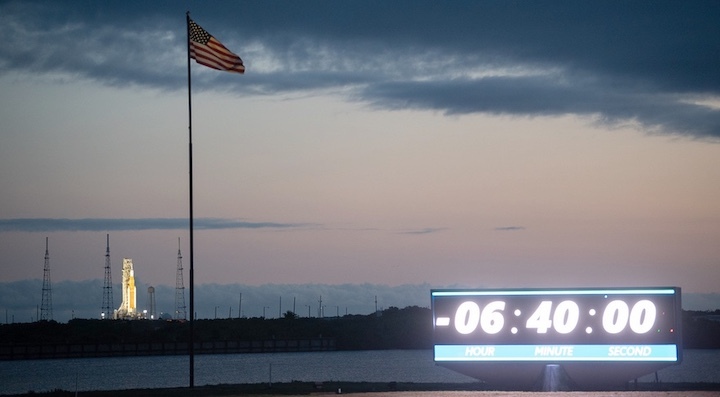
NASA started April 3 hoping to get through a practice countdown of the SLS, but a technical problem with its mobile launcher forced a scrub hours later. Credit: NASA/Joel Kowsky
Updated 6:30 p.m. with comments from briefing.
DENVER — NASA called off the first attempt to fuel its Space Launch System rocket and go through a practice countdown April 3, citing a problem with the rocket’s mobile launcher, but hopes to try again April 4.
NASA announced shortly before 12 p.m. Eastern that it was scrubbing its wet dress rehearsal (WDR) for the SLS before crews started loading any liquid hydrogen and liquid oxygen propellant into the vehicle. The agency said fans in the mobile launch platform, required to create positive pressure in enclosed areas of the platform to avoid a buildup of hazardous gases, were not working.
Charlie Blackwell-Thompson, NASA Artemis launch director, said in a call with reporters late in the day that one fan malfunctioned when a breaker tripped. Technicians were sent in to look at it but could not resolve it, so controllers switched to a redundant fan. “It wasn’t long after that we got the call that that fan, too, had experienced an issue,” she said, adding it was a different problem. “We made the decision to stand down to get into a configuration to go troubleshoot that.”
She said it should take four to five hours to resolve the problems. That would allow a second attempt at loading propellants onto the vehicle early April 4, following a schedule similar to what had been planned for April 3. The malfunctioning fans “is the only real issue” teams are examining, she added.
Even before the fan problem NASA was running behind schedule with the test, where the core and upper stages of the SLS are filled with propellants and go through a countdown that stops at approximately T-10 seconds. Severe thunderstorms April 2 delayed WDR activities at Launch Complex 39B, including several lightning strikes on protective towers at the pad.
There were four lightning strikes, including one particularly powerful one that hit a catenary between two lightning protection towers, said Mike Sarafin, NASA Artemis mission manager, on the call. All four were cleared before the the decision early April 3 to proceed with the WDR.
Blackwell-Thompson said the fan problems don’t appear to be linked to the lightning strikes. The fans had been running continuously at a lower speed since the launch platform arrived at the pad, and moved into a different mode for hazardous operations for several hours before the problem.
If NASA doesn’t complete the WDR on April 4, future plans will depend on how far into the test they get. Sarafin said if they get past a “certain point” in loading propellants, NASA would have to stand down for a couple days to replenish stocks of liquid hydrogen. If the test is scrubbed before that point, NASA may seek to try again April 5, but after that they run into “a number of range conflicts” like the launch of a Falcon 9 on the Ax-1 crewed mission to the International Space Station from neighboring Launch Complex 39A.
“We’ve got Monday [April 4] in the bag for sure as as attempt. Tuesday is a definite possibility but requires some additional coordination,” he said. “After that, we’ll have to play it day by day.”
NASA started WDR activities April 3 about one hour behind schedule, according to tweets posted by Jeremy Parsons, deputy manager of the Exploration Ground Systems program at KSC. Tweets and blog posts were the primary means NASA used to provide updates about the test after claiming that export control restrictions prevented it from providing audio from the launch control center or any other commentary.
The WDR is the final major test before the inaugural launch of the SLS on the uncrewed Artemis-1 mission. NASA officials said at a March 29 briefing that, if the test goes well, the agency could be ready in about a week to set a launch date for the mission, likely no earlier than June.
The WDR, while intended to simulate a countdown, offers greater flexibility to correct problems than what crews would have during an actual countdown. “We are fortunate to have this flexibility during today’s test, but would operate differently on launch day,” Parsons tweeted shortly before the test was scrubbed for the day.
Quelle: SN
